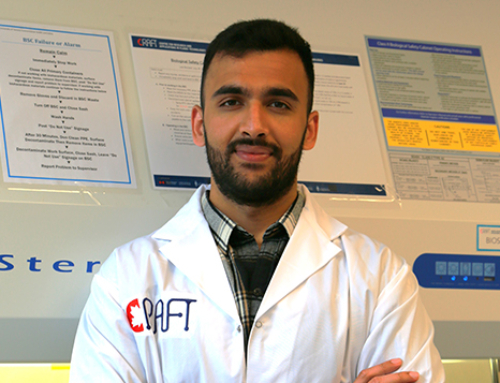 Meet the world-class researchers who are building the future of regenerative medicine. These are the people of Medicine by Design.
Meet the world-class researchers who are building the future of regenerative medicine. These are the people of Medicine by Design.
“At 14, I took a coding class because I was curious about programming. As the only girl in the class, I was intimidated, but I was also hooked right away. I continued to learn on my own after that class, and paid for university by working as a programmer each summer.

Maria Abou Chakra, Research Associate, Donnelly Centre for Cellular and Biomolecular Research, University of Toronto.
Later on in high school, when I started to plan what I would study in university, I was not ready, so I searched for advice. A teacher gave me their biology textbook so I could see what it was about, since I didn’t take high school biology, and in fact, I dropped it for the coding class I took. A few chapters in, I knew I wanted to learn more. But I was ineligible for the biology program in university, since I didn’t have a credit in biology. But I did not let that stop me from trying, so I called up the dean’s office and pleaded with her. She warned me it would be difficult, but she said yes. Ten years later, while I was serving in my university’s graduate pub, I recognized her. I approached her and thanked her, and told her I was completing a PhD in biology. She asked me to email her the details, and she made my day by attending my PhD defense.
I’ve been lucky that at every career milestone someone gave me an opportunity. In my undergrad, I didn’t specialize in any particular aspect of biology. When I applied for graduate school, the committee ranked my “dispersed” interests as my weak point. But my supervisor at the time wanted exactly somebody like me and he vouched for me, and my application was successful.
I’m currently working on tissue development models, which combines my two passions: biology and computer programming. I think modeling, fueled with cross-disciplinary approaches, can become a very powerful tool to predict and understand complex ideas. For instance, our team is interested in finding what drives cells to change and make decisions. There are so many answers and possible mechanisms, and current experimental tools cannot fully separate all of them. By using available information and computational tools, our model can predict patterns and provide possible answers.
The fun and challenging part of developing a model is when I don’t have enough information and I have to be creative to capture reality. This is where a diverse skill set is handy. Also, I have to get information across disciplines just to learn about a system properly. That is not always easy but makes for a stronger model.
My lab’s vision is that we can eventually push predictions to the next level. And that will be useful for regenerative medicine researchers because it will allow them to predict things before they are even tested in the lab. It might even change the way experiments are designed because if the model guides the experiment, costs could be reduced.
I have the privilege to be part of Medicine by Design where diversity and collaboration are supported and applied. I think working together to tackle problems using different tools and perspectives is the way to new discoveries that will shape the future.”
Why Dr. Abou Chakra is one of our People of Medicine by Design: Dr. Abou Chakra is a research associate in the lab of Professor Gary Bader, who is currently a co-investigator on three Medicine by Design team projects. Dr. Abou Chakra works on a project that studies self-repair in the brain and muscle.






